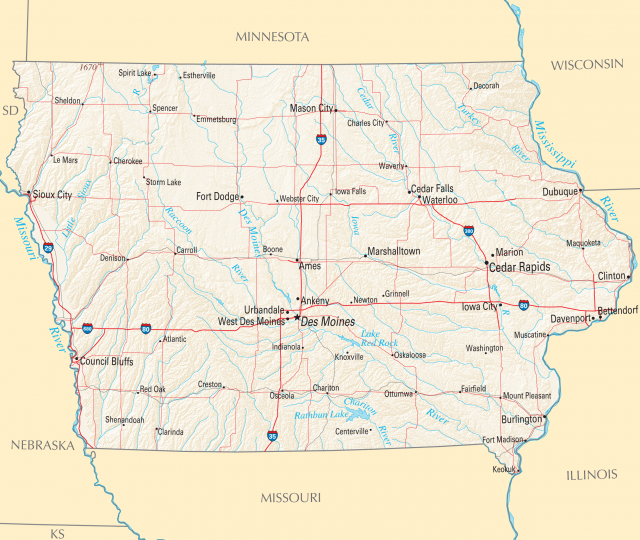The State of Iowa
AT A GLANCE
Name: Iowa is believed to have come from a Native American word meaning “this is the place” or “the beautiful land.”
Nickname: Hawkeye State
Capital: Des Moines
Size: 56,276 sq. mi. (145,755 sq km)
Population: 3,123,899 (2015 est)
Statehood: Iowa became the 29th state on December 28, 1846.
Electoral votes: 7 (2016)
U.S. Representatives: 5 (until 2016)
State tree: oak
State flower: wild rose
State bird: eastern goldfinch
Highest point: Osceola County, 1,670 ft. (509 m)

THE PLACE
Approximately 11,500 years ago, during the last Ice Age, Iowa was covered by glaciers. These huge mounds of ice, rock, and dirt carved the state into three distinct areas. The first is a glacier-leveled region in northern and central Iowa, that has some of the most fertile soil in the Midwest.
Uneven soil deposits resulted in beautiful lakes and characteristic swamps in this region. The southern portion of Iowa is much like the north, although the glaciers that once filled this area did not leave the land as rich or as flat as the northern and central parts of the state. The northeastern portion of Iowa was crossed by only one glacier, which left most of the area's original hills intact. The northeastern corner of Iowa is covered with pine trees and cliffs. The powerful Mississippi and Missouri Rivers form Iowa's eastern and western borders. In their valleys are some of the best hardwood forests in Iowa. Iowa's climate is extreme and can change quickly from day to day. Winter in Iowa is cold and snowy, while summer is usually hot.
Facts and Firsts
- Wright County has the highest percentage of grade A topsoil in the nation.
- Iowa is the only state with east and west borders that are formed by water. The Missouri and Mississippi Rivers mark Iowa's borders.
- Herbert Hoover, Iowa native and 31st president of the United States, was the first president born west of the Mississippi River.
- The campers and motor homes known as Winnebagos are manufactured in Winnebago County.
THE PAST
Like many other midwestern states, Iowa was once inhabited by prehistoric Native Americans who constructed earth mounds to bury their dead. More than 10,000 of these mounds remain throughout Iowa. The first Europeans to reach the area were the French explorers Louis Jolliet and Father Jacques Marquette, who arrived in 1673. A few French fur traders and settlers followed, but France gave the region to Spain in 1762.
The French later regained control, only to sell present-day Iowa to the United States as part of the Louisiana Purchase in 1803. In 1832, the region suffered during a brief war between the U.S. government and the Sauk and Fox tribes, who did not want to be relocated from their homeland in Illinois to unsettled Iowa.
Iowa came to be known as the Hawkeye State in honor of Chief Black Hawk, the leader of the Native American protesters. Iowa officially became a state on December 28, 1846. The growth of railroads in the 1870s and the large-scale construction of roads during World War I helped Iowa's agriculture industry expand. Iowa's economy suffered during the Great Depression of the 1930s, but the high demand for food during World War II helped the state recover.
Food processing and the production of farm equipment grew in importance. During the 1980s, Iowa again suffered from serious economic problems as its crops became less valuable, but the state recovered and continued to expand.
THE PRESENT
Iowa has changed a great deal during the last century. Though Iowa was once a primarily agricultural state that depended on corn as its main crop, today the state's manufacturing industries compete with its farms in economic importance. Although 93 percent of Iowa's land is used for farming, only about 10 percent of its inhabitants live on farms.
Iowa produces about 7 percent of the nation's food supply. The state grows a wide variety of crops, including soybeans and oats. Many farmers also raise hogs and cattle for meat and dairy products.
The capital, Des Moines, has become a national center for many insurance companies, as well as food processing and farm equipment factories. Many kinds of electrical equipment, including home appliances, are also manufactured in the state.
Born in Iowa
- Leon Bismarck “Bix” Beiderbecke, jazz musician
- Norman Borlaug, plant pathologist, geneticist
- Johnny Carson, television entertainer
- William Frederick “Buffalo Bill” Cody, scout, showman
- Mamie Doud Eisenhower, first lady
- George H. Gallup, poll taker
- Herbert Hoover, U.S. president
- Ann Landers, newspaper columnist
- John L. Lewis, labor leader
- Glenn Miller, bandleader
- Wallace Stegner, writer, environmentalist
- Abigail Van Buren, newspaper columnist
- John Wayne, actor
- Meredith Wilson, composer
- Grant Wood, painter